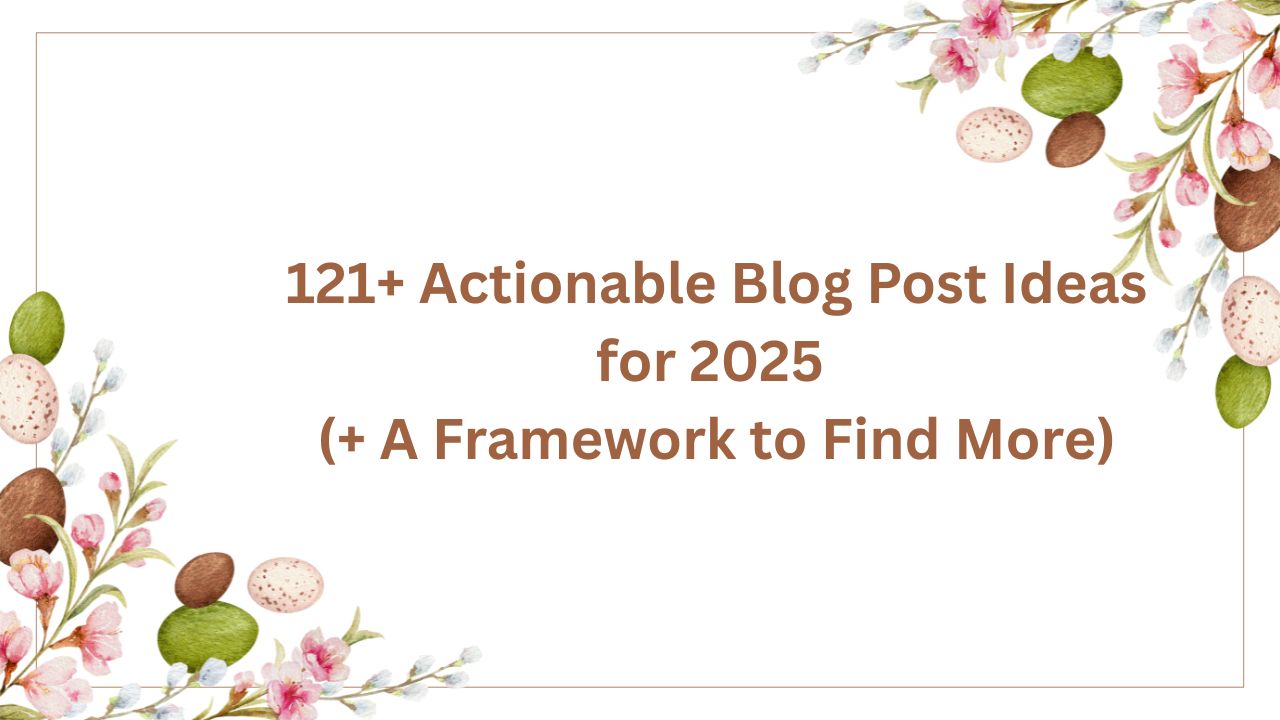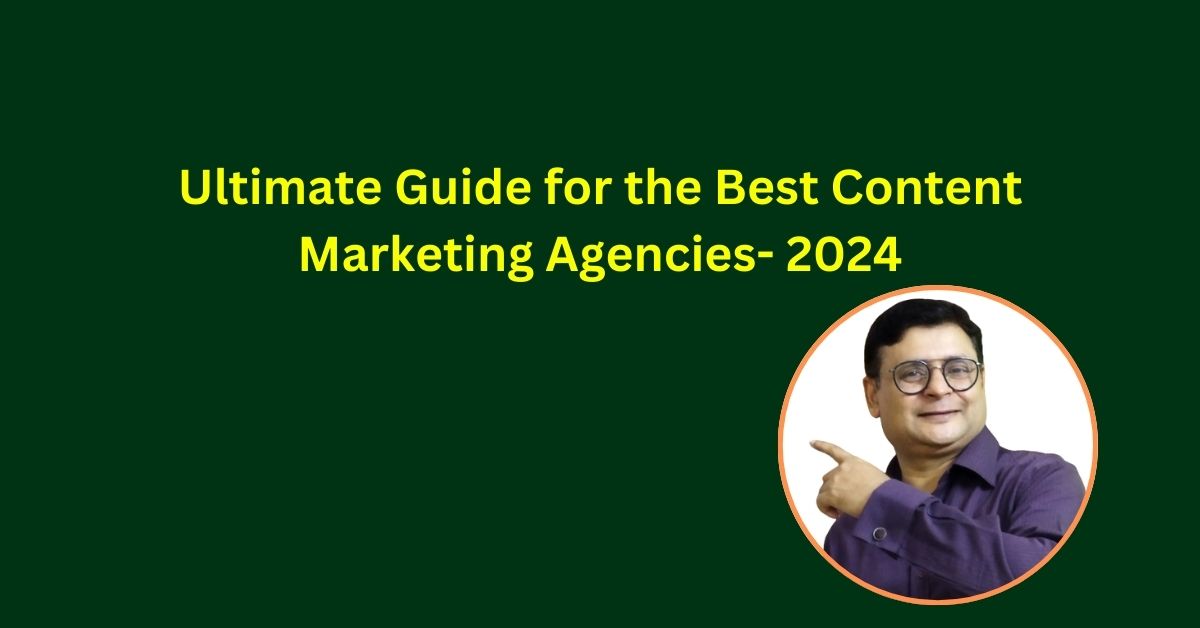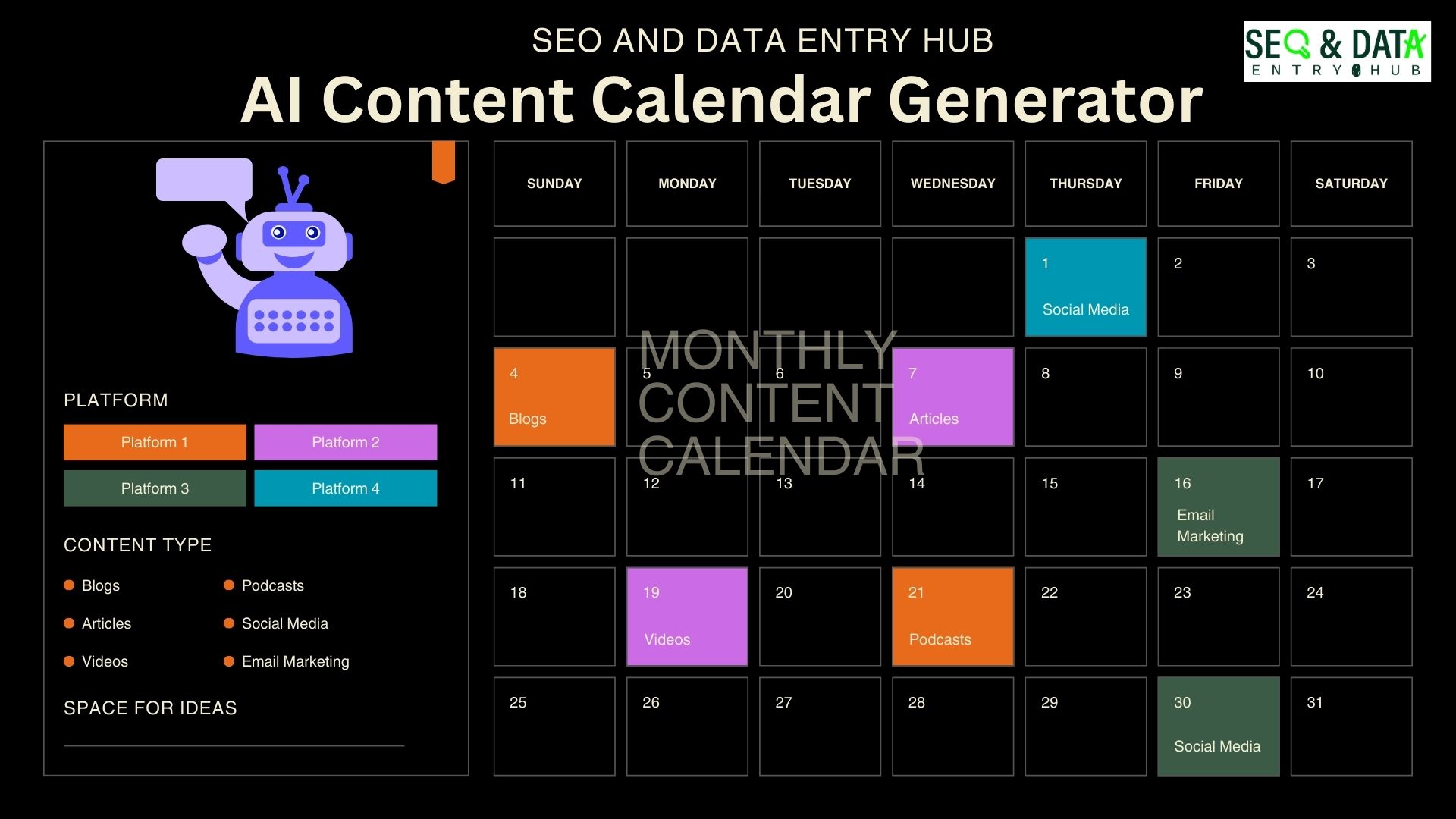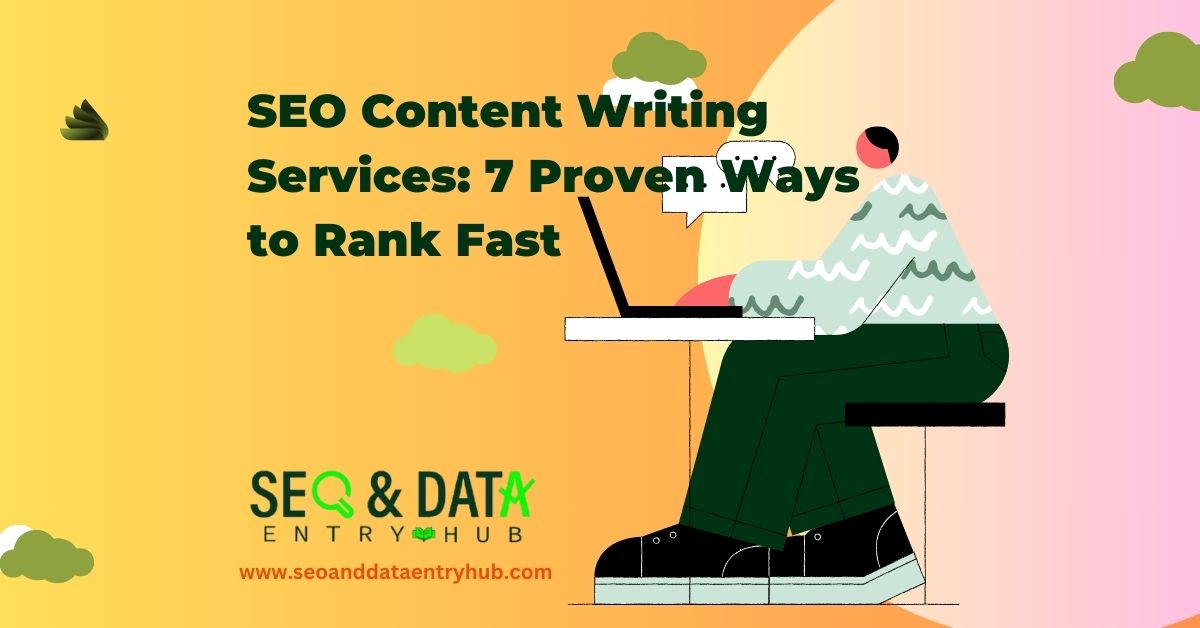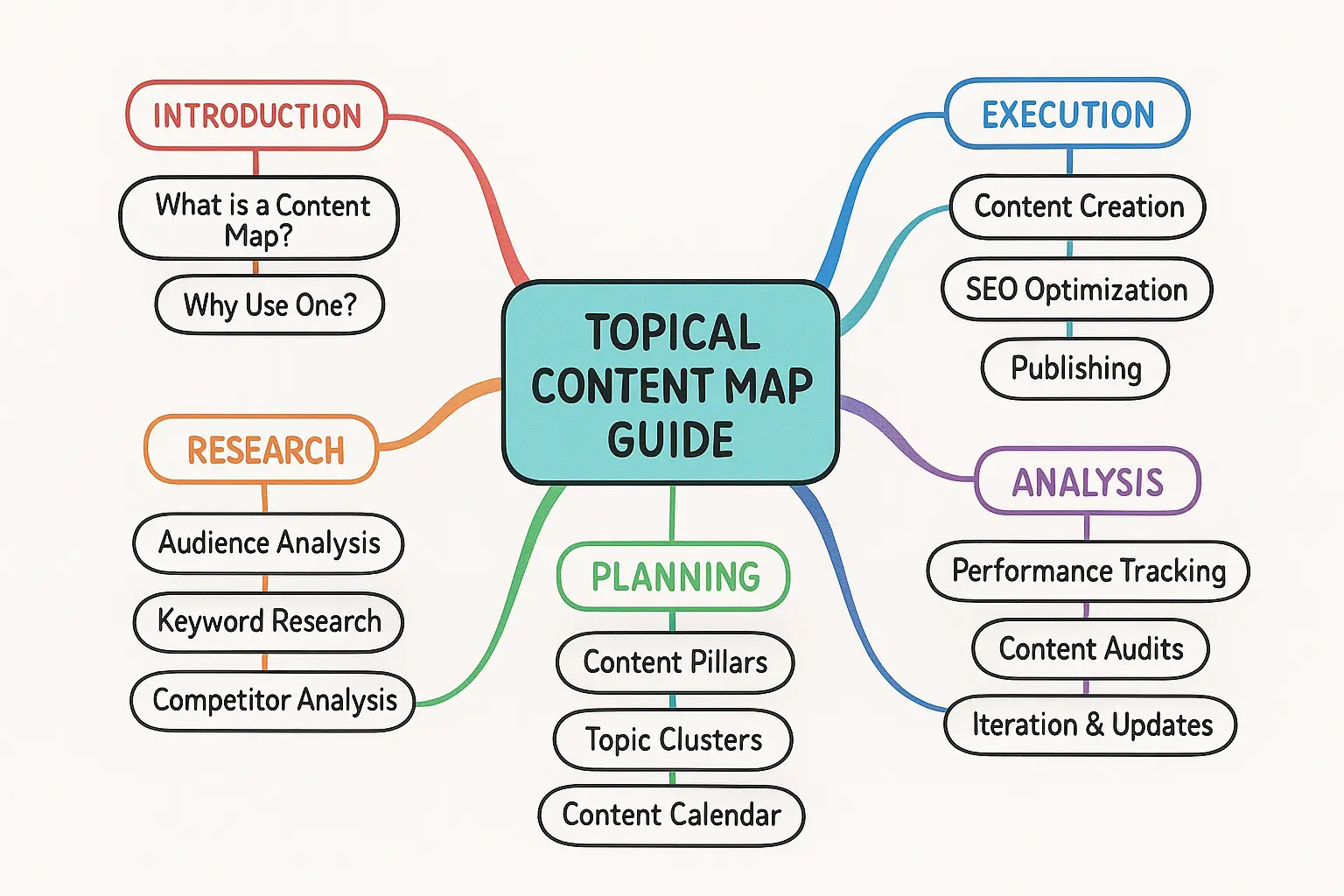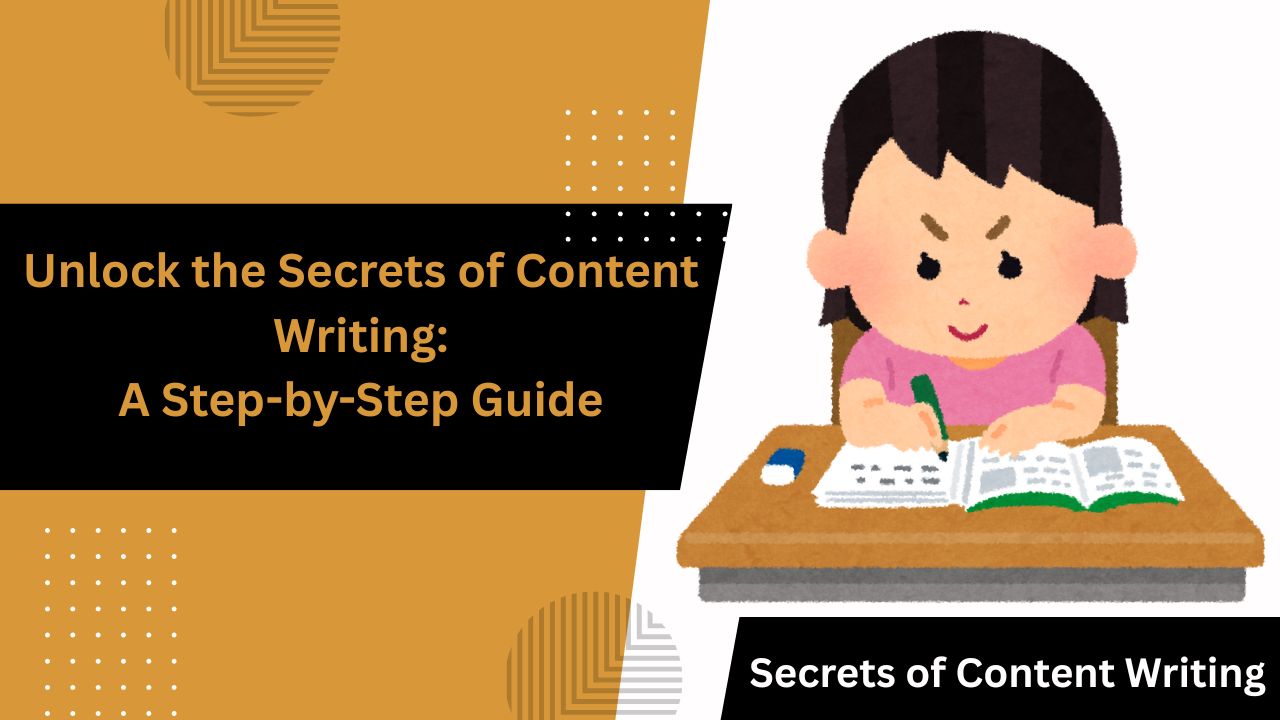(Table of Content) If you have time, please read the entire article or click on your desired section
ToggleContent Writing Career Guide: Path, Skills, Earnings, AI, Clients & Sustainable Growth
Content writing is not dead—it’s transforming.
What type of content is disappearing? Generic, keyword-stuffed posts that no one reads. What’s winning now is research-driven, performance-focused, and AI-assisted content that builds trust, educates, and converts.
Businesses still need writers who can think strategically, understand intent, and create content that drives results.
This guide gives you a clear roadmap for your content writing career path. Whether you are:
- A beginner asking, “How do I start?”
- A working writer stuck with low rates or endless revisions.
- A strategist who wants to scale authority and revenue
This guide is a comprehensive hub of career paths for content writers.
You will know: how to start, what skills to build, how the career path evolves, how to price and earn more, how to specialize, how to use AI responsibly, how to measure success, and how to stay sustainable without burning out.
You’ll learn every stage of growth— and even a 90-day action plan. By the end, you’ll know how to move from commodity execution to strategic authority and future-proof your career in an AI-driven world.
TL;DR
Content writing isn’t dead—it’s evolving. The best career path follows six stages:
1. Explore → 2. Beginner Writer → 3. Specialist → 4. Strategic Writer → 5. Manager/Authority → 6. Creator or Productized Expert.
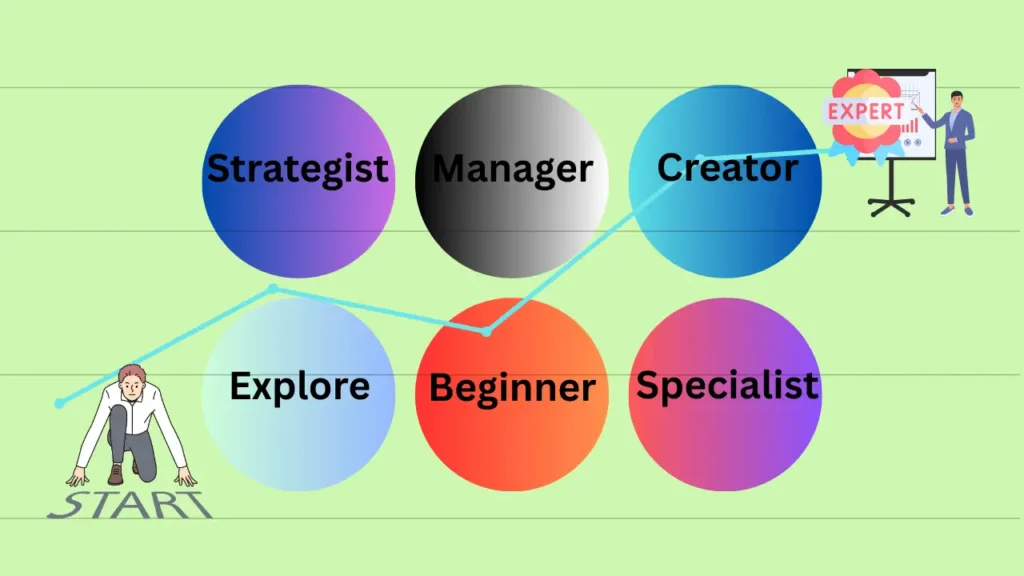
Is Content Writing a Dead-End Job or a Growing Career?
No—unless you stay stuck doing low-value work. The absolute dead-end is writing generic posts for low pay without considering the bigger picture. If you want growth, you need to level up.
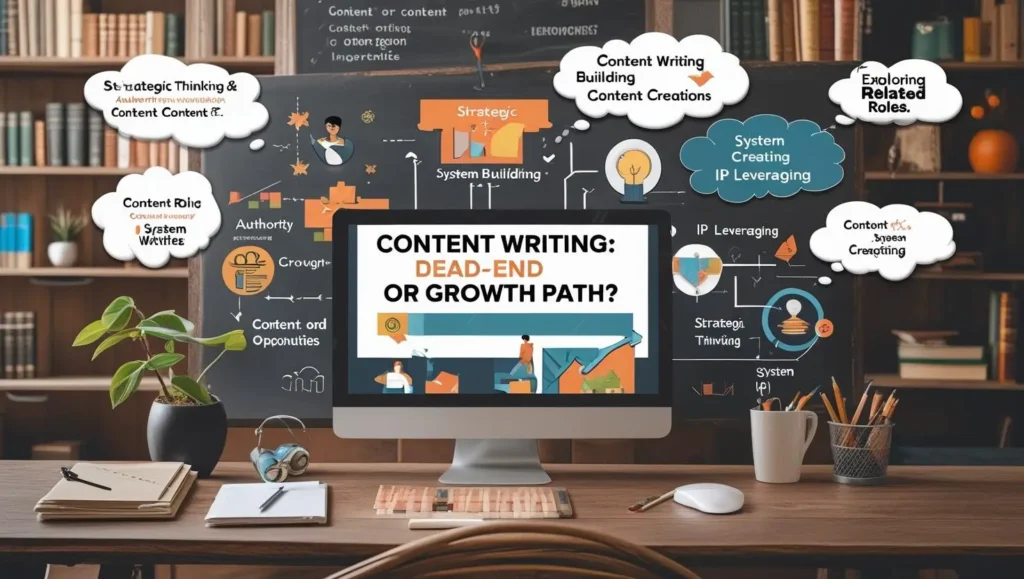
Organizations still struggle to turn “we need content” into assets that attract, convert, and retain customers. Writers who can bridge this gap don’t disappear—they get promoted, referred, and paid well.
Growth comes when you:
✅ Think strategically – You must go beyond keywords. You can understand search intent, conversion paths, and the business goal behind the content.
✅ Build authority – You choose a niche, develop expertise, and share your insights publicly.
✅ Create systems – You use perfect templates, SOPs, and analytics to make your work faster and more consistent.
✅ Leverage intellectual property (IP) – Turn your knowledge into courses, newsletters, or productized services.
✅ Explore related roles – Move into content strategy, SEO, UX writing, or even brand publishing.
Real Example:
I, Salauddin, started with $20 SEO blogs. Instead of staying stuck in keyword research, keyword difficulty (KD), and keyword golden ratio (KGR), I learned about topical mapping, internal linking strategies, and optimized for search intent.
The result? My clients saw a big jump in traffic. I positioned myself as a Growth-Focused Content Strategist and doubled (sometimes triple) my rates in five months. Soon after, I landed an in-house role leading an editorial team.
Will AI Replace Content Writers?
AI replaces repetitive drafting, not strategic thinking, narrative insight, or brand voice. The best writers use AI as an assistant, not a competitor.
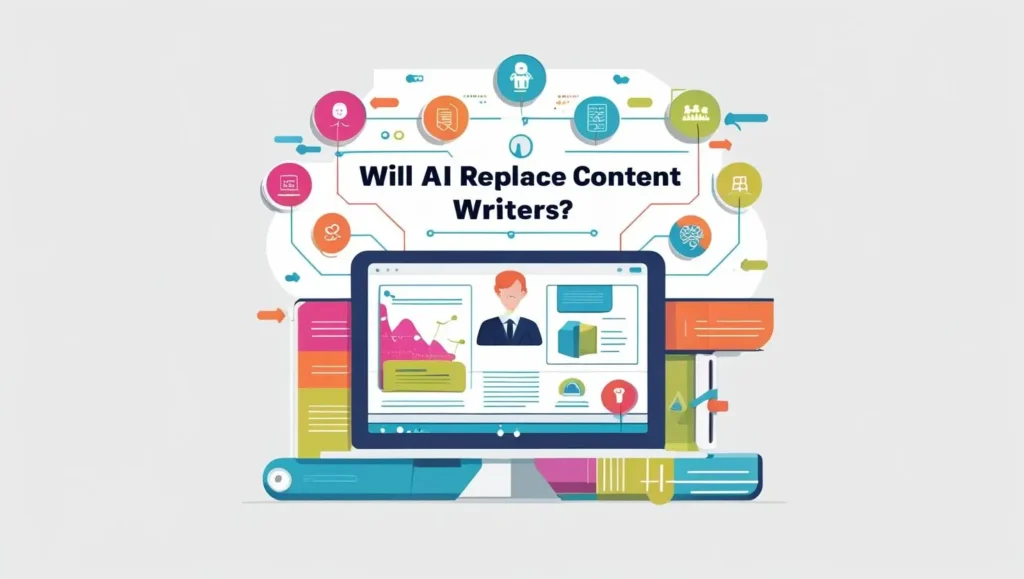
AI can help:
- To generate outline options and angle ideas.
- To summarize transcripts and research.
- To check style consistency and entity coverage.
What AI cannot replace:
- Original research and SME interviews.
- Human empathy and persuasive storytelling.
- Strategic integration across the buyer’s journey.
Takeaway: If you keep evolving—learning strategy, using data, and creating value—you’ll find that content writing is one of the most adaptable and rewarding career paths in digital marketing.
The Content Writing Career Path Framework: The 5 (+1) Stage
A content writing career path is not a straight line—it’s a series of stages where your skills, influence, and income grow over time.
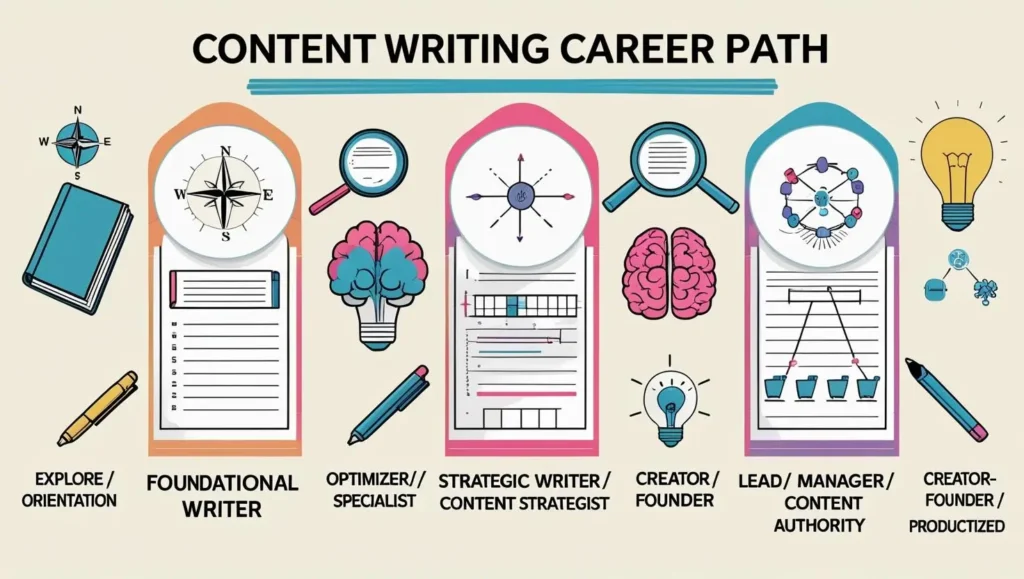
Below is the six-stage roadmap that most successful writers follow:
Stage Snapshot Table
| Stage | Label | Core Focus | Distinguishing Skills | Value Lever | Approx Timeline* |
| 0 | Explore / Orientation | Exposure & foundational habits | Research basics, structural mimicry, feedback seeking | Speed of skill assimilation | 2–4 weeks |
| 1 | Foundational Writer | Consistent, on-brief delivery | Style adherence, baseline on-page SEO, revision discipline | Reliability & volume | 2–6 months |
| 2 | Optimizer / Specialist | Performance & emerging niche depth | Intent mapping, content structure engineering, light analytics | Better outcomes per piece | 6–12 months |
| 3 | Strategic Writer / Content Strategist | Planning & pipeline contribution | Editorial calendaring, journey mapping, gap analysis | Predictable business impact | 1–2 years |
| 4 | Lead / Manager / Authority | Scale & leverage via systems | Coaching, SOP design, cross-functional alignment, dashboards | Organizational acceleration | 2–3 years+ |
| 5 | Creator-Founder / Productized | IP & revenue diversification | Offer design, audience building, repurposing, brand narrative | Multiplying monetization streams | Variable |
*Timelines are competency-based, not fixed.
How to Use the Framework
Stage 0: Explore / Orientation
Purpose:
You must build minimal essential skills if you genuinely enjoy content writing and can commit to it.
Success Criteria:
- Develop a daily micro-writing habit.
- Create 3–4 short writing samples.
- Reverse outline three strong articles to understand the structure.
Key Upgrades:
Practice structural mimicry (learn by analyzing great content), write concise sentences, and build feedback loops for improvement.
Common Mistakes:
Spending too much time consuming content without writing and publishing unedited drafts.
Transition Trigger:
You’re ready to move forward when you can produce and revise a clear, coherent 800–1,000-word article with minimal errors.
Action Checklist:
- Reverse outline three well-written articles.
- Create your personal style checklist for tone and clarity.
- Draft and revise your first sample twice before seeking feedback.
Stage 1: Foundational Writer/Producer
Success Criteria:
- Complete 10–15 full-length content pieces.
- Deliver work that follows the brief with predictable turnaround times.
- Reduce the need for major structural rewrites in your drafts.
Key Upgrades:
Master on-page SEO basics, adapt your style to different brand voices, and improve your self-editing skills.
Common Mistakes:
Stuffing keywords unnaturally, writing vague or weak introductions, and ignoring recurring feedback patterns.
Transition Trigger:
You’re ready for the next stage when editors make only small, nuanced changes—rather than rewriting entire sections.
Action Checklist:
- Keep a detailed revisions log to track patterns and progress.
- Standardize your workflow: Outline → Draft → Rest → Revise → Optimize.
- Suggest internal links when handing off your content for publishing.
Stage 2: Optimizer / Specialist
Success Criteria:
- Your content shows performance signals like higher CTR, better engagement, and early organic ranking improvements.
- You start leaning toward a niche or topic area.
- You refine content based on data rather than just guesswork.
Key Upgrades:
Learn how to clarify search intent, structure your content for a better user experience, and use basic analytics to measure performance.
Common Mistakes:
Specializing too narrowly too soon or focusing only on publishing high volumes without a strategy.
Transition Trigger:
You’re ready for the next stage when you can suggest new topics or formats—backed by clear reasoning and performance insights.
Action Checklist:
- Audit 5 existing pieces to improve introductions and overall structure.
- Write a clear positioning statement about what you offer and who you help.
- Do a mini performance review every month to track engagement and CTR.
Stage 3: Strategic Writer / Content Strategist
Success Criteria:
- You manage (or co-manage) an editorial calendar or topic cluster.
- Your content strategy covers different stages of the funnel—awareness, consideration, and conversion.
- You design content with clear conversion pathways, not just traffic goals.
Key Upgrades:
Learn how to find and fill content gaps that competitors miss. You must go deeper by mapping buyer personas and their real Jobs-to-Be-Done (JTBD). Finally, writers prioritize topics that bring the biggest impact instead of writing at random.
Transition Trigger: When stakeholders and decision-makers trust your content strategy, they will await your planning.
Common Mistakes:
Don’t fall for vanity metrics like traffic without conversions. And avoid publishing random one-off pieces with no strategy—they waste time and don’t move the needle.
Action Checklist:
- Create a cluster map to organize related content topics for SEO authority.
- Launch a simple performance dashboard to track rankings, engagement, and conversions.
- Standardize a strategic brief template for consistent planning and execution.
Stage 4: Lead / Manager / Authority
Success Criteria:
- Supporting and coaching writers to help them improve while clearing up any obstacles that slow them down.
- Documenting clear, actionable SOPs and keeping them updated regularly.
- Making sure different teams are working together smoothly and effectively, with no gaps or misunderstandings.
Key Upgrades:
- Being smart about resource allocation so the team focuses on the most important tasks.
- Telling the story of your team’s performance in a way that’s engaging and easy to understand.
- Helping the team grow by developing their skills and providing opportunities for improvement.
Mistakes to Watch Out For:
- Getting caught up in micromanaging, which can harm trust and creativity.
- Reporting data without turning it into action or making clear decisions based on it. Numbers should drive change, not just sit there.
Transition Trigger:
- The system should be strong enough to continue running smoothly, even when you’re not there. That’s when you know you’ve built something that can stand on its own.
Action Checklist:
- Set up a regular calendar for refreshing processes and documents to keep them relevant.
- Develop a simple QA checklist to maintain high standards across the board.
- Run monthly strategy reviews to look at what’s working, what’s not, and how to keep getting better.
Stage 5: Creator-Founder / Productized
Success Criteria:
- Building and owning your own audience channels where you control the relationship.
- Creating packaged offers, like productized services, programs, or digital products, makes it easier to scale your work.
- Diversifying your revenue streams so you’re not dependent on just one source of income.
Key Upgrades:
- Perfecting your offer architecture, ensuring everything is well-structured and easy to understand.
- Setting up a system to repurpose content and offers, making sure your work reaches more people.
- Creating a nurture funnel that builds relationships with your audience and converts them over time.
Mistakes to Avoid:
- Building complex products or offers before validating the demand—start simple and scale once you know what works.
- Underestimating the authority gap can make it harder to sell or position yourself as an expert in your field.
Action Checklist:
- Codify your signature framework—the unique approach or method you’ve developed that sets you apart.
- Launch a lead magnet that aligns with the core transformation you offer, so you attract the right audience.
- Test a pilot paid offer (like a micro-offer) to see what resonates with your audience and refine from there.
Callout:
- You can absolutely stay an advanced individual contributor (IC) and thrive in Stage 4; Stage 5 is optional if you’re not ready to scale.
Pro Tip:
Timelines can vary, but most writers typically reach Stage 2 in 6-12 months and Stage 3 in 18-24 months with consistent practice, feedback, and growth.
Competency Matrix: Skills at Every Stage
A successful content writing career path depends on building the right skills at the right time. This competency matrix shows how your abilities should evolve as you progress through the stages.
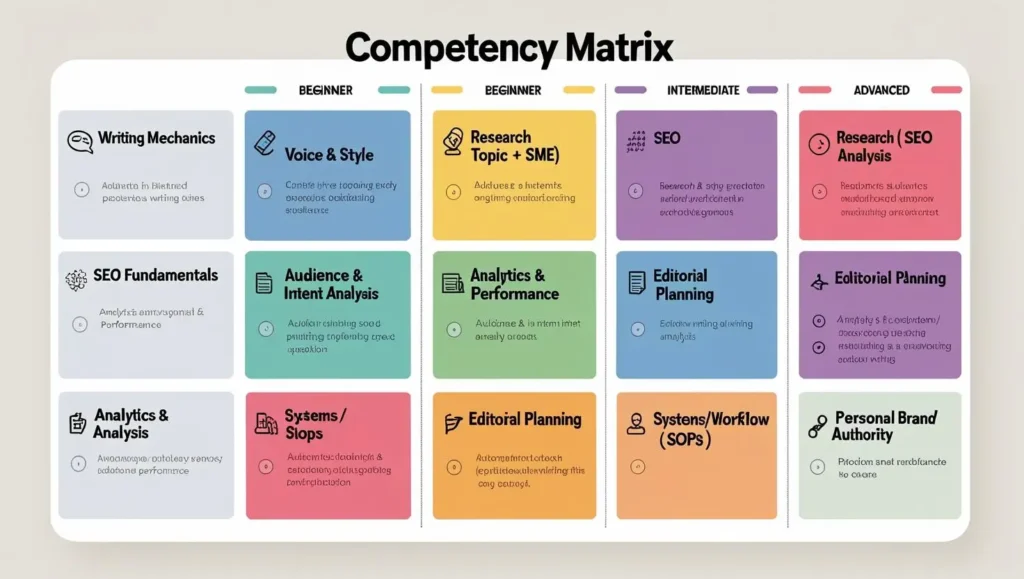
Core Skills by Stage
| Skill Area | Stage 0 | Stage 1 | Stage 2 | Stage 3 | Stage 4 | Stage 5 |
| Writing Mechanics | Intro | Working | Strong | Strong | Advanced | Advanced |
| Voice & Style | Intro | Working | Strong | Strong | Advanced | Advanced |
| Research (Topic + SME) | Intro | Working | Strong | Advanced | Advanced | Advanced |
| SEO Fundamentals | Intro | Working | Strong | Strategic | Strategic | Strategic |
| Audience & Intent Analysis | N/A | Intro | Working | Strong | Advanced | Advanced |
| Analytics & Performance | N/A | Intro | Working | Strong | Strategic | Strategic |
| Editorial Planning | N/A | N/A | Intro | Working | Advanced | Strategic |
| Systems / Workflow (SOPs) | N/A | Intro | Working | Strong | Advanced | Advanced |
| Stakeholder / Client Management | Intro | Working | Strong | Advanced | Advanced | Advanced |
| Strategic Narrative / Positioning | N/A | Intro | Working | Strong | Advanced | Advanced |
| Leadership & Coaching | N/A | N/A | Intro | Working | Strong | Advanced |
| Personal Brand / Authority | Optional | Optional | Emerging | Working | Strong | Advanced |
| Offer / Product Design | N/A | N/A | N/A | Intro | Working | Strong |
How to Use This Matrix
- Stage 0–1: Focus on writing clarity, grammar, and basic SEO.
- Stage 2: Add intent mapping, structural optimization, and performance checks.
- Stage 3+: Layer on strategy, analytics, leadership, and IP creation.
Rule of Thumb: Don’t skip foundational craft. Strategy without strong writing skills creates fragile results.
✅ Pro Tip: Use this matrix for self-audit. Identify 2 weakest leverage skills and design a 30–90 day improvement sprint.
Salary & Rate Progression in the Content Writing Career Path
Your earnings as a content writer increase with complexity, performance impact, and strategic contribution. Below is a snapshot of typical income growth across stages.
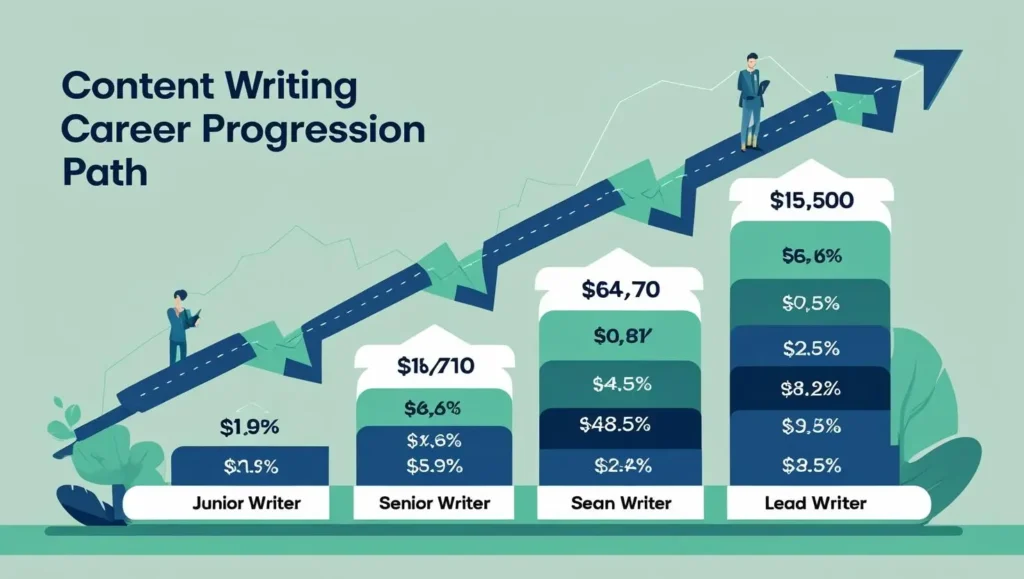
| Stage | Relative Freelance Rate Index | Typical In-House Role |
| Stage 1: Foundational Writer | 1.0× | Junior Content Writer |
| Stage 2: Optimizer / Specialist | 1.5–2.0× | Content Writer / Specialist |
| Stage 3: Authority Builder / Strategic Contributor | 2.0–3.0× | Senior Writer / Content Strategist |
| Stage 4: Lead / Manager | 3.0–5.0× | Lead / Head of Content |
| Stage 5: Creator-Founder / Productized | Non-linear | Founder / Principal Consultant |
Illustrative Earnings Ranges
(Varies by region, niche, and proof of results)
- Entry Level (Stage 1): $0.06–$0.15 per word or $60–$180 per basic article.
- Intermediate (Stage 2): $0.15–$0.35 per word or $200–$500 per optimized piece.
- Specialist / Authority (Stage 3): $0.30–$0.70 per word or $500–$1,500+ for strategic assets.
- Strategic Retainers (Stage 4): $2,000–$8,000+ per month for system design and governance.
- Productized Services (Stage 5): Courses, frameworks, and consulting—earnings can scale beyond hourly or per-word limits.
Value Levers That Increase Your Rates
- Enhance Proof: Back up your value with measurable results—whether it’s an increase in CTR, higher rankings, or more conversions.
- Strategic Integration: Go beyond just writing. Offer a full package that includes content briefs, editorial calendars, and optimization plans to show you’re thinking strategically.
- Packaging: Move away from charging per word and start offering project bundles or outcome-based pricing that better reflects the value you bring.
✅ Pro Tip: Don’t get caught in the trap of competing solely on price. Instead, focus on standing out with clear communication, proven credibility, and performance-driven content that delivers results.
Portfolio That Gets You Hired (Not Ignored)
A basic list of samples won’t land high-paying clients anymore. Why? Because anyone can have a few links. What makes you stand out is proof of results—showing that your writing drives traffic, engagement, or conversions.
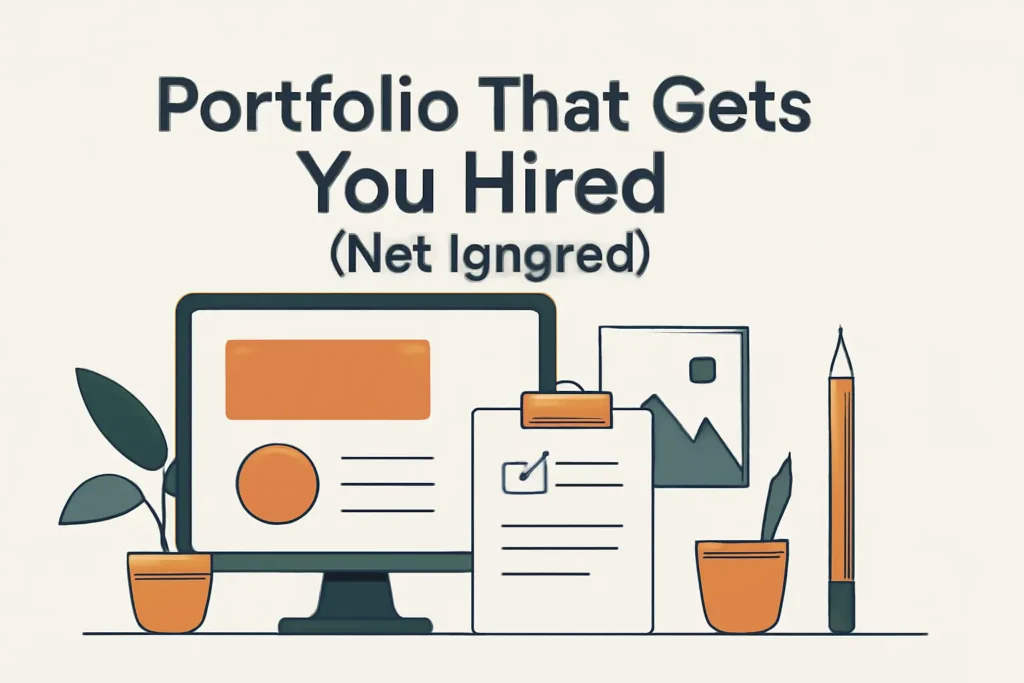
What Should a Strong Portfolio Include?
- Your best pieces (flagship content)
- Context: Who the piece was for and why it was created
- Results: Data like traffic growth, leads, or engagement
- Your edge: What makes your writing unique
No Clients Yet? Here’s How to Build Portfolio Samples Fast
- Write guest posts for blogs in your niche. This is a great way to demonstrate your expertise while getting your name out there.
- Create spec pieces (make sure they’re clearly labeled as samples). This allows you to show the kind of work you can do, even if you don’t have client projects yet.
- Refresh old articles to showcase your ability to improve content—highlight the before-and-after changes to prove your skills.
- Partner with an SME (Subject Matter Expert) for a more authoritative touch. It adds credibility and shows you can collaborate effectively.
Case Snippets: How to Tell the Story Behind Your Portfolio Samples
- Problem: What issue were you trying to solve?
- Diagnosis: How did you identify the problem?
- Approach: What strategies did you use to fix it?
- Outcome: What improvements or results came from your work?
- Takeaway: What’s the key lesson you learned from this?
Example:
“The client’s blog wasn’t getting much traction. I adjusted the content strategy, focused on search intent, and added internal links. The result? A 65% traffic boost in just 90 days.”
Avoid Portfolio Overload
Your portfolio shouldn’t be cluttered with too many links. Instead, select five to ten of your best pieces and organize them by niche or content type to keep things focused and relevant.
✅ Pro Tip: Focus on creating a portfolio that highlights your strategic thinking and results, not just your writing ability.
Getting Clients and Jobs: The P.A.I.D. Acquisition Model for Content Writers
Struggling to find clients or land jobs as a content writer? Most beginners waste time on low-paying gigs and generic platforms.
The solution?
A proven client acquisition strategy that builds authority, trust, and long-term relationships is the best way to get clients and jobs. That’s where the P.A.I.D. model comes in.

Subtitles with Explanations:
P – Platforms That Work (Not Time-Wasters)
Choose curated job boards and niche communities like Slack or LinkedIn groups. Avoid oversaturated marketplaces like Fiverr, where writers race to the bottom on pricing.
A – Authority Seeds
You must plant trust signals as early as possible. Share mini case studies, content tear-downs, or short video breakdowns on LinkedIn or Twitter. These authority seeds show potential clients your expertise before they even hire you.
I – Intent Lists
You don’t need to wait for jobs to appear. Build a spreadsheet of target companies that need better content—like outdated pricing pages or missing comparison posts. This gives you leverage for personalized pitches.
D – Direct Pitches That Convert
Send personalized outreach emails highlighting:
- The gap you found (e.g., missing SEO page).
- A micro sample showing how you’d fix it.
- An outcome-focused angle (traffic, conversions).
- A soft CTA (e.g., “Would you like me to send a draft outline?”).
Retention: Turn Clients into Long-Term Revenue
After delivering the project, you can send clients a mini performance report (CTR, ranking changes, engagement). Then propose a retainer for updates or new content. This keeps income predictable and positions you as a growth partner—not just a writer.
✅ Pro Tip: Avoid over-reliance on “daily payout” listings—they’re fine for practice, but not for building a strong brand or portfolio.
Measuring Success (Metrics Ladder)
If you want to grow your content writing career, you can’t stop at publishing. Clients want proof that your content works. Measuring performance helps you improve and justify higher rates.
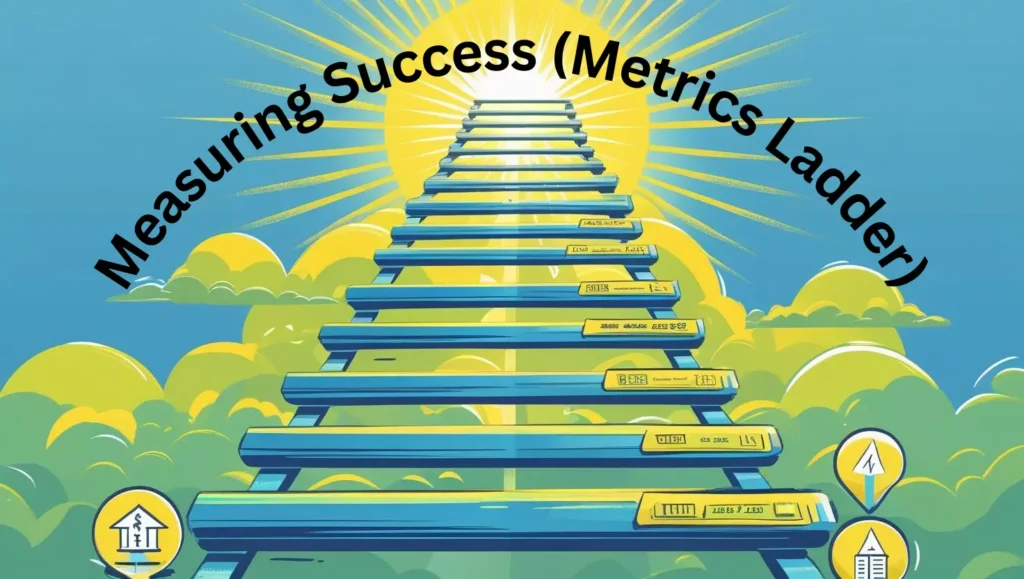
Here’s a simple Metrics Ladder you can use:
| Layer | Metrics | Purpose |
| Visibility | Impressions, indexing speed, SERP feature capture | Validate optimization & coverage |
| Engagement | CTR, scroll depth, engaged time, bounce shift | Improve hooks & structure |
| Durability | Rank stability, decay rate, SERP feature retention | Refresh prioritization |
| Conversion Influence | Assisted conversions, demo/signup journey paths | Asset ROI justification |
| Retention & Expansion | Onboarding completion, help center deflection, upsell enablement | Lifecycle support |
| Efficiency | Refresh uplift %, content velocity, cost per performing asset | Operational scaling |
✅ Pro Tip: You should assign one primary KPI (e.g., demo sign-ups) and one diagnostic metric (e.g., CTR). Track progress using a simple Content Performance Dashboard. This helps you measure content impact and identify areas for improvement.
Performance Log:
URL | Intent | Primary KPI | 30/60/90 Day Metrics | Refresh Due
90-Day Starter Implementation Plan
If you’re starting your content writing career path, you need structure—not endless guessing. This 90-day plan provides a clear roadmap to build skills, create proof assets, and position yourself for better-paying work.
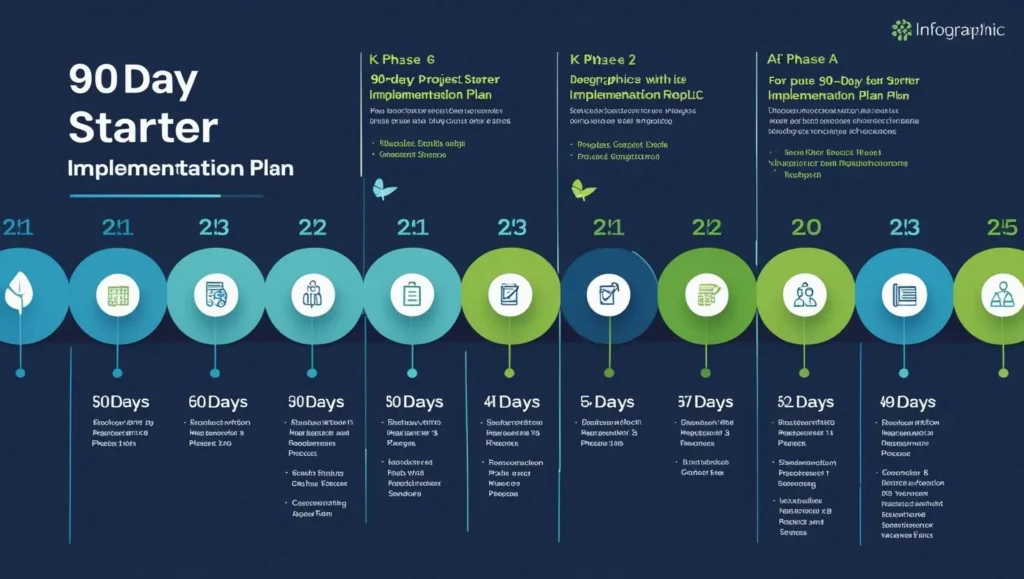
Phase 1 (Days 1–30): Foundation
Goal: Build habits and craft your first polished samples.
- Weekly Actions:
- Write 3 drafts.
- Do 1 reverse outline (deconstruct a strong article).
- Run 1 feedback loop.
- Milestones:
- Create a personal style checklist.
- Produce your first polished 800–1,000-word piece.
Phase 2 (Days 31–60): Volume & Feedback Systems
Goal: Improve quality, speed, and confidence.
- Weekly Actions:
- Write 2 new drafts.
- Optimize 2 existing pieces.
- Track revision patterns.
- Conduct 1 structured feedback session.
- Milestones:
- Publish a simple portfolio page.
- Show reduced revision ratio and faster turnaround.
Phase 3 (Days 61–90): Performance & Positioning
Goal: Add measurable impact and stand out in your niche.
- Weekly Actions:
- Write 1 niche-focused piece.
- Refresh 1 older draft for optimization.
- Do 1 mini performance review (CTR, engagement).
- Start outreach with a gap-based pitch.
- Milestones:
- Complete 6–8 polished samples.
- Create a positioning statement (e.g., “Helping SaaS brands boost signups with conversion-focused content”).
- Receive your first inbound inquiry or paid project.
✅ Pro Tip: Pair execution with reflection. Every piece should teach you something about structure, audience, or performance.
Lead Magnet CTA:
Accelerate Your Content Writing Career in 90 Days
A practical, friendly, no‑fluff roadmap to move from “order‑taker” to a strategic, higher‑paid writer.
You’ll Get:
- 30/60/90 Weekly Planner
- Revision Log & Style Checklist
- Positioning Statement Worksheet
- Portfolio Impact Story Template
- Gap-Based Outreach & Follow-Up Scripts
- Content Performance Log (KPI Ladder)
- V.E.N.N. Niche Filter Worksheet
- A.I.A.D.D. AI Prompt Workflow Sheet
- R.E.S.E.T. Burnout & Energy Audit Form
Core Win: 6–8 proof pieces, clear positioning, measurable performance in 90 days.
Why It Works: Turns scattered effort into structured sprints with KPIs and leverage assets.
Advanced Leverage: Specialization, Systems, and IP
Once you’ve mastered the basics, the fastest way to grow your content writing career path is by stacking leverage—through specialization, systems, and intellectual property.
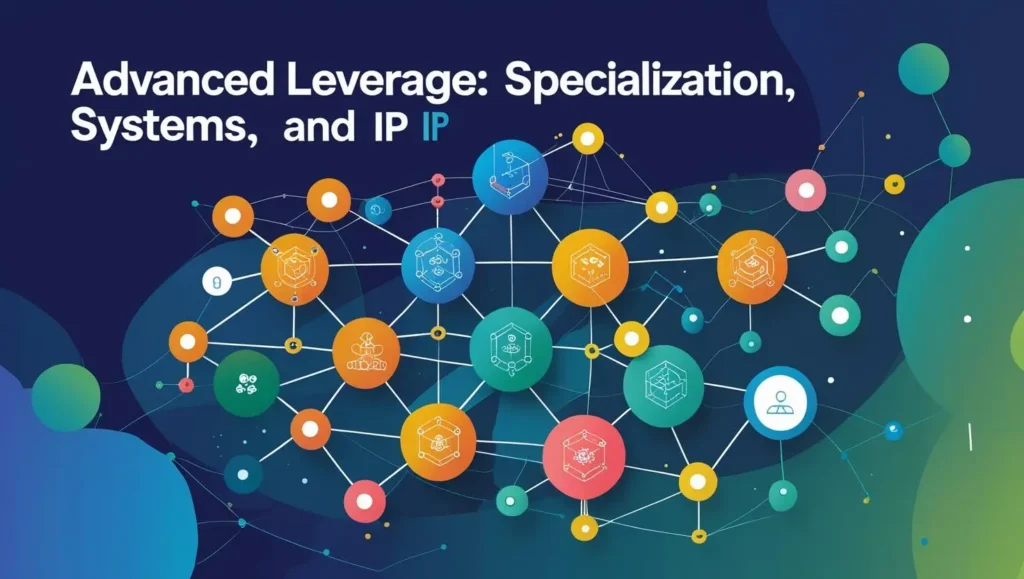
1. Specialization (Pick Your Niche)
Why specialize?
- Higher rates, less competition.
- Easier client acquisition through authority positioning.
- Better quality work because of deeper knowledge.
How to choose your niche:
Use the V.E.N.N. Filter:
- Viability – Does the niche have ongoing budgets?
- Experience – Do you have transferable knowledge?
- Navigability – Can you access SMEs and resources easily?
- Novelty – Can you bring a unique perspective or framework?
Examples of profitable niches:
- SaaS & tech onboarding content
- Healthcare & FinTech compliance
- Conversion-focused comparison pages
- Thought leadership ghostwriting
2. Systems (Scale Without Burnout)
You can’t increase income by only increasing output. You need systems:
- Brief templates for consistency.
- Editorial calendars for planning.
- Refresh cycles to update and repurpose content.
- Performance dashboards to track ROI.
✅ Pro Tip: Writers who manage process + performance move into Content Strategy or Head of Content roles.
3. Intellectual Property (IP) & Productized Offers
Don’t limit yourself to client work. Turn your expertise into scalable assets:
- Courses or workshops (e.g., SEO Writing for SaaS).
- Signature frameworks (e.g., your 5-step content system).
- Productized services (e.g., “SEO cluster package with 30-day performance report”).
Authority accelerators:
- Publish framework-based posts on LinkedIn.
- Host short live sessions or micro-webinars.
- Build an email newsletter around your niche expertise.
✅ Takeaway: At advanced stages, income is no longer tied to word count—it’s tied to strategy, systems, and owned IP.
AI and the Future of Content Writing
AI isn’t replacing good writers—it’s forcing a shift in what “good” means. The advantage now goes to writers who can blend:
- Machine efficiency (speed, structure, coverage)
- Human strengths (judgment, originality, credibility, story)
Think of AI as a power tool. It can rough-in the frame—but you still design the house, choose the materials, and pass the inspection.

What AI Can Do Well
- Structural outlining: Generates multiple outline variants so you can pick, merge, or improve.
- Angle scaffolding: Surfaces with less obvious entry points you might overlook under a deadline.
- Summarization: Compresses transcripts, webinars, and interview notes into usable blocks.
- Pattern + consistency checks: Flags tone drift, format breaks, passive voice overload.
- Entity & topical coverage: Helps ensure you include related concepts that users (and search engines) expect.
- Reformatting: Turns long-form into snippets: email blurbs, social posts, FAQs.
- Variant generation: Rapid A/B phrasing for CTAs, headings, intros.
- Data wrangling (light): Converts tables, lists, and messy notes into readable prose.
What AI Cannot Replace
- Narrative judgment: Choosing the right angle for this audience at this moment.
- Voice stewardship: Guarding against generic sameness. Brand tone fractures fast with blind prompting.
- Source discernment: Knowing which stat is outdated, biased, or misquoted.
- First-hand depth: Insights from SMEs, users, customers, experiments, or lived experience.
- Strategic framing: Tying a feature, idea, or problem to business impact or user motivation.
- Ethical filtering: Spotting subtle hallucinations, invented attributions, or copyright hazards.
- Credibility signals: Quotes, methodology notes, citations, dates, author expertise, and transparency.
- Emotional calibration: Knowing when to push urgency vs. reassurance vs. aspiration.
The A.I.A.D.D. Workflow for Writers
A.I.A.D.D. is a simple editorial routine for working with AI. It makes writing easier by turning scattered prompts into a guided, reliable draft.
Assess
Clarify: Who’s this for? What decision or belief shift do we need? What channel? What is the search or discovery intent (navigational, problem-aware, solution-aware, comparison, post-purchase)?
Output: A short creative brief (goal, audience tension, angle hypothesis, key sources).
Instruct
Give the model scaffolding, not vagueness:
- Role (You are a product marketer / technical educator/analyst)
- Audience sophistication (novice, practitioner, exec)
- Desired structure (intro: tension → insight → solution path)
- Constraints (voice: direct, no fluff; avoid clichés like “in today’s fast-paced world”).
- Prompt in steps; don’t ask for the final article first.
Assemble
Pull together:
- AI-generated outline variants
- Your SME quotes, case snippets, internal metrics, customer language (from call notes or surveys)
- Verified stats (with source + year)
- Merge into a draft where every section has a purpose—not just word count filler.
Distill
Trim repetition. Replace abstractions with specifics. Add friction-removing transitions. Mark where visuals, tables, or diagrams would increase comprehension. Swap generic verbs (“utilize,” “leverage”) with precise ones (“model,” “deploy,” “audit”).
Double-Check
Run a manual or tool-assisted pass for:
- Fact + date verification (anything older than 24 months—revalidate)
- Source provenance (primary vs. tertiary blogs)
- Compliance / brand-sensitive claims
- Proper attribution & copyright for images, code, data
- Performance hooks: headline clarity, scannable subheads, metadata, internal links, schema opportunities.
A Quick Mental Model
AI = Draft breadth
Human = Meaning depth
Performance = Relevance × Credibility × Distinctiveness
You win by owning depth and distinctiveness while letting AI accelerate breadth.
Common Pitfalls & How to Avoid Them
Even experienced writers stall when they unknowingly optimize the wrong things. Use this list as a periodic self-audit.
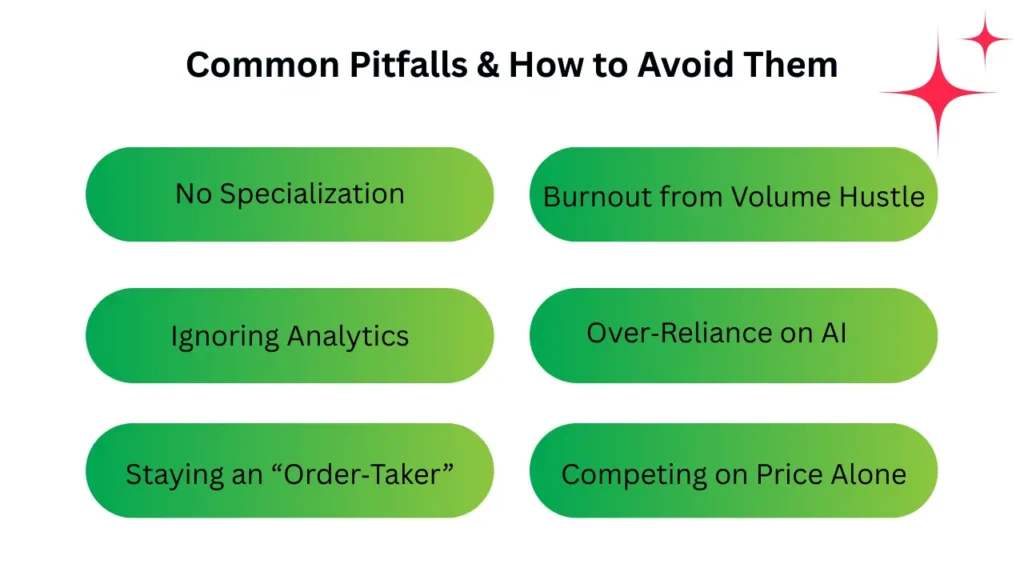
1. Staying an “Order‑Taker”
Trap: Accept every brief at face value; no strategic input.
Signal: You rarely ask “What’s the primary KPI?”
Fix: Clarify goal, audience intent, desired action. Propose internal links, stronger CTAs, or content gaps to fill.
Quick Win: Add a “Goal / Intent / Primary KPI” header to every brief you receive before drafting.
2. Competing on Price Alone
Trap: Dropping rates to win work → churn + burnout.
Signal: Prospects compare you purely on per‑word pricing.
Fix: Package outcomes (e.g., “Topic cluster + performance review”) instead of selling words.
Quick Win: Replace per‑word quote with a 3‑tier deliverable menu (Starter / Performance / Strategic).
3. Ignoring Analytics
Trap: You “ship and forget.”
Signal: You can’t cite last month’s best‑performing asset or why.
Fix: Track a primary KPI (e.g., demo signups) + one diagnostic (CTR or scroll depth). Review monthly.
Quick Win: Create a simple sheet: URL | Intent | Primary KPI | 30/60/90 metrics | Refresh decision.
4. Over‑Reliance on AI
Trap: Paste AI output; minimal original sourcing or angle.
Signal: Drafts sound interchangeable across brands.
Fix: Use AI for outline variants, summaries, phrasing; inject SME quotes, data, lived examples. Follow A.I.A.D.D.
Quick Win: Require 3 human-sourced insights (interview note, internal metric, customer quote) per article.
5. No Specialization
Trap: Generalist forever; rates stagnate.
Signal: Your positioning line changes weekly or is absent.
Fix: Apply V.E.N.N. (Viability, Experience, Navigability, Novelty) to choose a niche; publish frameworks in that lane.
Quick Win: Ship a positioning statement: “I help [Audience] achieve [Result] with [Method/Angle].”
6. Burnout from Volume Hustle
Trap: Income tied to raw output; quality + enthusiasm degrade.
Signal: Rising revision loops; procrastination before starting drafts.
Fix: Shift to value-based pricing, implement SOPs, add refresh cycles, cap net‑new assets.
Quick Win: Replace one new piece this week with a high‑leverage refresh (improve intro + internal links + CTA clarity).
R.E.S.E.T. (Sustainable Output Layer)
R.E.S.E.T. is the sustainability layer that protects your leverage—maintaining quality, performance, and strategic focus as output scales so you avoid burnout and the slide back into commodity volume.
R – Rhythm: Time‑block distinct phases (Research → Draft → Cool‑off → Revise → Optimize) to cut context switching. Signal: ≥80% of planned deep blocks honored.
E – Experimentation: Run 1 micro test weekly (intro, CTA, angle) for incremental lift + creative novelty. Signal: Test logged with metric (CTR, scroll depth, conversion).
S – Scoping: Write a ≤200‑word brief (Audience, Intent, Promise, KPI) before outlining to prevent mid‑draft drift. Signal: Structural rewrites <15%.
E – Energy Audits: Weekly 5‑minute review: list tasks → rate Drain (1–5) vs Impact (1–5); batch, eliminate, or delegate one mismatch. Signal: High‑drain / low‑impact tasks decline over weeks.
T – Throughput Caps: Set max net‑new pieces + refresh ratio (e.g., 3 new / 2 refresh) to protect quality. Signal: First‑pass acceptance steady; revision loops not increasing.
Install Rhythm + Scoping first; layer Experimentation as you track metrics; add Energy Audits + Throughput Caps once volume rises.
✅ Pro Tip: Revisit this checklist monthly; if two signals slip simultaneously (e.g., honored deep work blocks drop AND rewrites spike), pause expansion and restore the baseline before scaling again.
Frequently Asked Questions (FAQ)
1. Is content writing a good career?
Yes, if you focus on strategic, research‑backed content rather than mass “filler” writing. Companies still invest in writers who can link content to the pipeline, product education, or retention.
As you layer skills (research, optimization, performance analysis, positioning), your earning ceiling rises and you become harder to replace.
2. Will AI replace content writers—and how should I use it?
No, AI won’t replace strong strategic writers; it replaces only repetitive drafting and surface summaries.
Treat AI as a power tool: use it to brainstorm outline variations, tighten wording, repurpose long pieces, or compare competitor angles.
Keep the human grip on original positioning, data interpretation, story flow, brand nuance, and trust signals (quotes, lived examples, authoritative sources).
3. How do I start with no experience?
Start by creating 4–5 spec (sample) pieces that look like real, purposeful assets: a comparison page, a product‑led guide, a data‑supported analysis, a framework explainer, maybe a teardown.
Label them as “Spec,” annotate each with Persona, Intent, Differentiator, and Intended KPI.
Then pitch with a specific gap you spotted (e.g., “Your pricing page lacks internal links to the calculator tool—here’s how I’d structure that section.”). Specificity beats generic “I’m a writer” outreach.
4. What skills matter most for content writers?
You grow in layers: (1) clear structure and plain English, (2) deep, credible research and source discernment, (3) optimization for search intent and internal linking, (4) performance literacy (CTR, scroll depth, assisted conversions), (5) strategic planning (topic clusters, refresh cadence), (6) AI orchestration, (7) collaboration with SMEs and marketing, (8) building repeatable systems. Don’t chase everything at once—lock each layer before the next.
5. How long does it take to become “good”?
You can become baseline competent in 2–3 focused months, competitive in 9–12 months, and strategically valuable in 18–24 months with deliberate practice.
Speed increases if you niche early (you recognize patterns faster, reduce research ramp time, and produce stronger angles). Track your own progress quarterly: samples → performance proof → frameworks → strategic recommendations adopted.
6. What does the career path look like?
Most writers move: Executor → Optimizer → Authority Builder → Strategic Contributor → Specialist (industry or format) → Strategist / Lead.
Early, you prove reliability; mid‑stage, you connect content to metrics; later, you design systems (brief templates, refresh logic, internal linking maps) and advise budget or roadmap.
System design and measurable impact are the inflection points that unlock higher retainers or leadership roles.
7. How much can content writers earn?
Income ranges widely: entry work might be modest per‑word or flat fees; mid‑level writers package assets (e.g., a 5‑piece cluster with internal link map); advanced strategists sell retainers that bundle net‑new + refresh cycles + quarterly performance reviews.
Rates rise with (a) niche difficulty, (b) performance evidence (e.g., “improved trial signups +22%”), (c) proprietary processes (audit frameworks, scoring models). Show the transformation, not just the word count.
8. How should freelancers set rates fairly?
Stop quoting purely per word. Estimate Base Time (research + drafting + revisions) × Complexity (technical depth, stakeholder interviews, compliance) + a Performance Premium once you have results.
Convert into outcome bundles like: “Mini Topic Cluster (3 pieces) + Internal Link Map + 60‑Day Performance Report.” Review pricing every 2–3 accepted cycles where revision rounds are light—that’s evidence you’re underpriced.
9. How do I build a portfolio without paying clients?
Create “spec” assets grounded in real products or industries (clearly mark them as spec). For each: include a 1‑paragraph strategic brief, show how you’d measure success (Primary KPI + diagnostic metric), and note refresh trigger points (e.g., “If CTR < 3% after 45 days, test alternative intro hook.”).
This demonstrates you think beyond drafting. A Notion or simple site with 5 polished, annotated samples often outperforms a bloated, unfocused portfolio.
10. How do I get clients—and avoid burnout while growing?
Consistent, focused visibility beats scattershot outreach. Share one useful teardown or framework weekly (authority seeding), send gap‑based personalized pitches (short Looms work), engage genuinely in niche communities, and follow up after delivery with early performance signals (indexing, improved internal link flow, rising scroll depth).
To stay sane, apply the R.E.S.E.T. model (Rhythm, Experimentation, Scoping, Energy Audits, Throughput Caps) and schedule refresh work (optimizing proven performers) so you’re not trapped in an endless net‑new treadmill.
Conclusion: Your Next Step on the Content Writing Career Path
A content writing career path is not a fixed track—it’s a ladder of skills, strategy, and leverage. What begins as simple writing can grow into content strategy, leadership, or even business ownership if you build the right systems and specialize.
The opportunities are real, but so are the challenges:
- Low-paying gigs if you stay in generic writing.
- Burnout from volume hustle.
- AI disruption if you don’t adapt.
The solution? Focus on performance, specialization, and continuous learning. Follow the career framework, competency matrix, and 90-day plan in this guide to build authority and sustainable income.
Your career is not just about words—it’s about influence, strategy, and measurable impact.
Related Resources
To go deeper into specific areas, explore these supporting guides (coming soon):
- [How to Start Content Writing with Zero Experience]
- [SEO Writing Tips for Beginners]
- [Content Strategy vs Content Writing: Key Differences]
- [AI Tools for Content Writers: How to Use Them Without Losing Originality]
- [High-Income Niches for Content Writers in 2025]
Call-to-Action (CTA)
Ready to take control of your content writing career path?
✅ Download the Free 90-Day Implementation Plan – Build skills, create proof assets, and start landing high-value clients.
📌 Bookmark This Page – This guide is your roadmap. Keep it handy as you progress.
✅ Pro Tip for Interlinking: Link your cluster pages under Related Resources to build topical authority for SEO.
Author Bio
Salauddin Biswas – SEO Specialist, Content Writer, and AI Content Editor
I’m Salauddin Biswas, founder of SEO & Data Entry Hub and Co-founder of S A Websoft. I am a content strategist with a research background. I help businesses turn ideas into content that ranks, engages, and drives results. Over the years, I’ve worked with brands across industries to blend SEO, data insights, and human storytelling—so they stand out in a crowded online space.
You can Visit Our Social Pages:
To get our services Hire me on Fiverr



